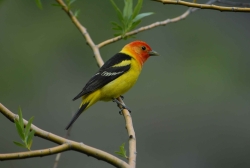
Courtesy Pixabay
Growing up in Smithfield Canyon in northern Utah, I heard birds singing every day. We had the incredible luxury of having variety of native plants and trees in our yard and the yards of our neighbors. The natural landscape of the canyon makes every yard bird friendly!
When my husband Marc and I moved to downtown Logan, we realized we need to be more intentional about creating bird friendly yards. We purchased two feeders to attract birds to the yard. We started with a globe feeder filled with black oil sunflower seeds, a sock feeder filled with nyjer thistle, and a suet cage.
I set up the feeders where I had the best line of sight from where I spent the most time at home. I was really disappointed that the birds weren’t coming to my feeders! After a bit of research, I learned that I need to place the feeders where the birds are most comfortable, near trees, bushes, and flowers where they can take cover and enjoy food from native plants.
Taking note of this, I relocated the feeders near bushes and trees and rearranged the furniture in my home to allow me a better view. Because relocating the feeders took them farther from my home, I put a small pair of binoculars in the console of our couch so I could grab them quickly if a bird landed at the feeder.
Black Oil Sunflower Seeds (Chickadees, Finches, Grosbeaks)
Black oil sunflower seeds feed the widest number of birds year-round, including chickadees, finches, pine siskins, and grosbeaks. If you are new to attracting birds to your yard, start with black oil sunflower seeds.
Learning to recognize different species by sight and sound is made easier by paying attention to your feeders. If you are lucky birds will stay at the feeder for 30 seconds, giving you time to study the markings or grab your binoculars for a closer look. The globe feeder with black oil sunflower seeds helped me learn the difference between a pine siskin and a female finch.
Looking at photos posted in the Facebook Group, Birding in Utah, I noticed a pattern of beautiful Evening and Black-Headed Grosbeaks at platform feeders. I had not realized that different birds utilize different styles of feeders! I ordered a platform feeder, filled it with black oil sunflower seeds, and soon had Grosbeaks at my feeders at home.
Nyjer Thistle
A nyjer thistle sock or feeder will bring goldfinches to your yard. I love trying to determine the difference between American goldfinches and lesser goldfinches. This task becomes even more challenging when you begin to see differences in males, females, and juveniles. This type of identification is meditative for me and has been an especially important form of self-care for me through the COVID-10 pandemic. T
Grape Jelly
This spring, I added a grape jelly feeder to my feeding station. I was working from home and engaging in a Zoom call. I happened to look out of my window at the jelly feeder and nearly screamed with delight when I saw a yellow warbler enjoying the jelly. I took note of the general time it visited and took a photo of it at the feeder on the weekend.
Resources
I use eBird, a website and app, to track bird sightings in my yard. Ebird helps me know the dates I can expect to see migrating birds in my yard. I love to look at the data to see which birds I am recording most often and the months that I see the most density.
Like many of you, I have been spending more time at home due to the coronavirus pandemic. In mid-May, I looked out the window to see a Western Tanager, my favorite bird, perched on the top of a hook holding my feeders. Spending more time at home has become an opportunity to take small steps to make my yard more bird friendly. The birds give me something to look forward to every day and they are a great reminder for staying present and hopeful for the future.
This is Mykel Beorchia from the Bridgerland Audubon Society and I am wild about Utah.
Credits:
Photos:
Courtesy Pixabay,
Audio: Courtesy and Copyright Kevin Colver
Text: Mykel Beorchia, Bridgerland Audubon Society and University and Exploratory Advising, Utah State University
Additional Reading
About eBird, https://ebird.org/about
Note: eBird is a project of the Cornell Lab of Ornithology and is supported entirely by grants, sponsors, and donations.
Grow a Bird Friendly Yard:
Hummingbird Nectar Recipe, Smithsonian’s National Zoo & Conservation Biology Institute, https://nationalzoo.si.edu/migratory-birds/hummingbird-nectar-recipe
Feeding Birds, Project Feederwatch, Cornell Lab of Ornithology, https://feederwatch.org/learn/feeding-birds/
Ebersole, Rene, How to Create a Bird-Friendly Yard, National Audubon Society, July-August 2013, https://www.audubon.org/magazine/july-august-2013/how-create-bird-friendly-yard
D. Mizejewski, Attracting Birds, Butterflies and Other Backyard Wildlife (Reston, VA: National Wildlife Federation/Fox Chapel Publishing, 2004). https://www.amazon.com/National-Wildlife-Federation-Attracting-Butterflies/dp/1580111505/
Publisher Website: https://foxchapelpublishing.com/national-wildlife-federation-r-attracting-birds-butterflies-backyard-wildlife.html
Certify Your Wildlife Habitat, National Wildlife Federation, Accessed 20 July 2017, https://www.nwf.org/Home/Garden-For-Wildlife.aspx
Certify: https://www.nwf.org/Garden-For-Wildlife/Certify.aspx
Creating Landscapes for Wildlife… A Guide for Backyards in Utah, Written by Sue Nordstrom and Illustrated by Kathlyn Collins Department of Landscape Architecture and Environmental Planning, Utah State University with Margy Halpin, Utah Division of Wildlife Resources; Second Printing 2001,
Updated for the Utah Division of Wildlife Resources, by Frank Howe, DWR Avian coordinator; Ben Franklin, DWR–Utah Natural Heritage Program botanist; Randy Brudnicki, DWR publications editor; and landscape planning illustrations by Stephanie Duer.,
Published by:
State of Utah Natural Resources, Division of Wildlife Resources,
Utah State University Cooperative Extension Service and
Utah State University Department of Landscape Architecture and Environmental Planning;
1991 updated 2001 https://wildlife.utah.gov/pdf/landscapingforwildlife.pdf
United States Department of Agriculture, Plants Profile: Littleleaf Mock Orange. Found online at: https://plants.usda.gov/java/profile?symbol=PHMI4
United States Department of Agriculture, Plants Profile: Garrett’s Fire Chalice. Found online at: https://plants.usda.gov/java/profile?symbol=EPCAG
Plant Lists & Collections, Recommended Species by State, Lady Bird Johnson Wildflower Center, www.wildflower.org/collections
Attracting Hummingbirds to your Yard, Human Wildlife Interactions, Utah State University Extension, April 2015, https://extension.usu.edu/wildlife-interactions/featured-animals/other-animal-topics/hummingbirds.php
